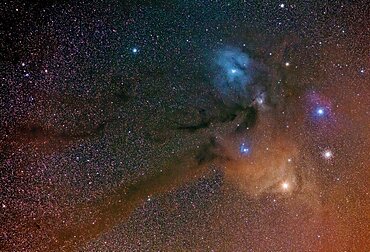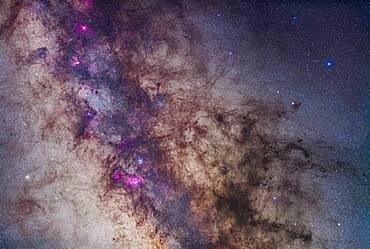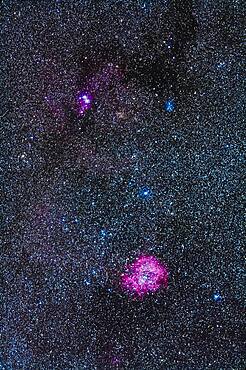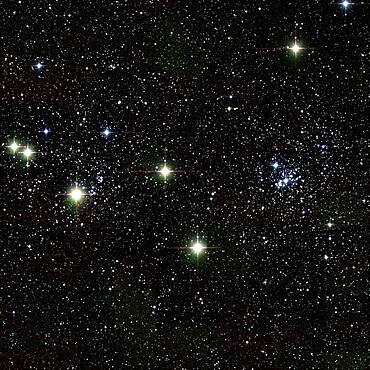Recent searches
Loading...
832-396709 - Emission Nebula NGC2244, Rosette Nebula with open star clusters in the constellation Unicorn, Bavaria, Germany, Europe
832-396708 - Emission Nebula NGC2244, Rosette Nebula with open star clusters in the constellation Unicorn, Bavaria, Germany, Europe
832-396707 - Star cluster Pleiades with reflection nebula, Messier 45, M45
1349-928 - NGC 2362, Caldwell 64, Tau Canis Majoris Cluster, Open Cluster
1349-1560 - Great Carina Nebula and Star Clusters, Atacama Desert, Chile
1350-80 - The Moon in total eclipse, on January 20, 2019, in a multiple exposure composite showing the Moon moving from right to left (west to east) through the Earth's umbral shadow.
1350-25 - The Pleiades star cluster, aka Seven Sisters, or M45, in Taurus. A deep exposure showing the reflection nebulosity which fills the area. This is a stack of 5 x 14 minute exposures with the TMB 92mm apo refractor and Borg 0.85x flattener/reducer at f/4.8 and Canon 5D MkII at ISO 800. Taken from home Oct 9/10, 2013.
1350-56 - This is the rich region in the centre of the constellation of Auriga with the Flaming Star Nebula, IC 405 at right, and the roundish IC 410 at bottom with the cluster NGC 1893. At top left is the star cluster Messier 38, with small NGC 1907 below it. The small nebula at left is IC 417 around the loose cluster Stock 8. The large elongated nebula at top is Sharpless 2-230. The colourful asterism of stars between IC 405 and IC 410 is the Leaping Minnow or Little Fish, aka Mel 31.
1350-54 - The Hyades star cluster with the red giant star Aldebaran (looking yellow here) in Taurus the bull in the winter sky. The field is similar to what a pair of large binoculars would show. I shot this from home Nov. 25, 2019.
1350-87 - A mosaic of the region in Cassiopeia and Cepheus containing the main nebulas: the Bubble Nebula (NGC 7635) at lower left, and the Cave Nebula (Sh 2-155) at upper right. At left is also the bright Messier open cluster M52. The small yellowish cluster at right is NGC 7419. The small cluster at lower centre is NGC 7510. The small nebula just left of centre is NGC 7538.
1350-45 - This is the central area of Cygnus and its bright Milky Way starcloud surrounded by red nebulosity. At left is the star Sadr (gamma Cygni) with the complex of nebulosity catalogued as IC 1318. At centre is the distinct Crescent Nebula, NGC 6888, a expanding nebula created by winds from a hot Wolf-Rayet star. At bottom left is the star cluster Messier 29, though looking a little lost in the rich starfields here. At top is the cluster IC 1311, looking more obvious than M29 but not observed visually and included in the NGC catalog. Odd. At far right are the large and loose star clusters NGC 6883 and NGC 6871, the latter an obvious binocular sight. To the left of Sadr is the small cluster NGC 6910. The dark nebulas B145 and LDN 862 are at right. The small emission nebula at bottom is Sharpless 2-104.
1350-178 - The asterism of the False Cross in Vela and Carina, at left, with Gamma Velorum, a bright blue supergiant star, at right. In between are faint arcs of nebulosity in the Gum Nebula. To the left of Gamma Velorum is the open star clister NGC 2547. Below the bottom star of the False Cross, Epsilon Carinae or Avior, is the large naked-eye star cluster NGC 2516. To the right of the right star of the False Cross, Delta Velorum, is the loose open cluster IC 2391.
1350-81 - The Moon in mid-total eclipse, on January 20, 2019, with it shining beside the Beehive star cluster, Messier 44, in Cancer. This was the unique sight at this eclipse as it can happen only during total lunar eclipses that occur in late January. There was one on January 31, 2018 but the next will not be until 2037.
1350-133 - The amazing area of the southern Milky Way in Carina and Crux, the brightest part of the Milky Way after the galactic core region. At right is the Carina Nebula, with the Southern Pleiades cluster, IC 2602, below it. The Football Cluster, NGC 3532, is at upper left of the Carina Nebula. At centre is the region of Lambda Centauri, with the star cluster NGC 3766, the Pearl Cluster, above the emission nebulosity. At left is the Southern Cross, with the dark Coal Sack at bottom left of the Cross, with thin tendrils extending to the right. To the left of Alpha Cruxis at the bottom of the Cross is the star cluster NGC 4609; aboive Alpha is NGC 4649. To the left of Beta Cruxis at the left side of the Cross is the Jewel Box Cluster, NGC 4755.
1350-24 - The Orion Nebula complex consisting of M42, M43 and the reflection nebula area known as the Running Man Nebula, NGC 1973-5-7. NGC 1981 is the blue star cluster at top north edge. North is up, though in the sky from Australia where this was shot the object appeared upside down compared to this northern-centric view.
1350-135 - The colourful region around Antares in Scorpius, the yellow star at centre. To the right is the globular cluster Messier 4. Above right of Antares is the smaller globular NGC 6144. Above are the nebulas associated with Rho Ophiuchi. The area is filled with reflection (yellow and blue) and emission nebulas (red and pink). The field simulates a binocular field.
1350-58 - This is the nebula rich region in the constellation of Monoceros the Unicorn with the dark Cone Nebula (left of centre) and the small V-shaped and bright Hubble's Variable Nebula at bottom, a reflection nebula that varies in form and brightness. Above the Cone Nebula is the triangular Christmas Tree Cluster, NGC 2264, here upside down as the bright blue star 15 Mon is the base of the tree. The large region of nebulosity is Sharpless 2-273. The V-shaped dark nebula above centre is LDN 1603.
1350-35 - A mosaic of the region around the Small Sagittarius Starcloud and Dark Horse dark nebula complex. The field takes in the Milky Way from the Lagoon Nebula at bottom to the Eagle Nebula at top left. In between from top to bottom are the Swan Nebula (M17), and the Small Sagittarius Starcloud (M24). Flanking the bright M24 starcloud are the large open clusters M23 (right) and M25 (left). At bottom left is the M22 globular star cluster. The prominent dark nebula at right is the large Pipe Nebula (B78) with the small Snake Nebula (B72) above it. The whole complex is visible to the naked eye as the Dark Horse.
1350-105 - The spectacular field of Messier 8 and 20 emission and reflection nebulas in Sagittarius, with M8, aka the Lagoon Nebula below, and M20, the Trifid Nebula, above, all set in the rich starfields of the Milky Way. The diffuse nebula left of M8 is NGC 6559. Two globular clusters, NGC 6544 and NGC 6553, sit below and to the left (east) of M8. The Messier open cluster, M21, sits above M20.
1350-79 - The Belt and Sword region of Orion, with the Orion Nebula, Messiesr 42 and 43, at bottom. Below the left star of the Belt, Alnitak, is the famous Horsehead Nebula, while above it is NGC 2024, aka the Flame Nebula. At very top left is Messier 78, while part of Barnard's Loop arc across the field at left. The field is filled with other faint red emission and blue reflection nebulas. The large loose open cluster Collinder 70 surrounds the middle star of the Belt, Alnilam.
1350-94 - The Orion Nebula, M42 and M43, with surrounding associated nebula and star clusters, such as the Running Man Nebula above (NGC 1975) and blue star cluster above it, NGC 1981.
1350-47 - This is the Belt of Orion with its three blue stars across the top of the frame (L to R: Alnitak, Alnilam, and Mintaka), with the iconic Horsehead Nebula (aka B33) below Alnitak, with the dark Horsehead set against the bright nebula IC 434, aka Orion's Dagger. The pinkish nebula above Alnitak is NGC 2024, the Flame Nebula. The small blue reflection nebula left of the Horsehead is NGC 2023, with smaller IC 435 to the left of it. The field is filled with the large open cluster Collinder 70. The multiple star at bottom left of centre is Sigma Orionis. Many other smaller bits of reflection nebulas populate the field in and around the Belt.
1350-82 - The area of the Rosette Nebula (bottom) and Christmas Tree Cluster (top) in Monoceros with the Fornax Lightrack tracker and 200mm lens + Canon 5D MkII. The nebulosity at top includes the Cone Nebula.
1350-22 - The complex area of clusters and nebulosity in central Auriga, including: M38 the Starfish Cluster and its smaller companion cluster NGC 1907; the emission/reflection nebulas NGC 1931, IC 417, IC 410 and IC 405 (from right to left here). Magenta and cyan (from emission and reflection components) IC 405 at right is the Flaming Star Nebula. Between IC 405 and IC 410 is the asterism known as The Little Fish.
1350-49 - The large emission nebula IC 1805 in Cassiopeia, aka the Heart Nebula. The round nebula at top right is NGC 896. The large loose star cluster at centre is Mel 15; the star cluster at left is NGC 1027. The small cluster below NGC 896 is Tombaugh 4.
1350-30 - The False Comet Cluster area of southern Scorpius, which includes the open cluster NGC 6231 and emission nebula IC 4628, and open cluster NGC 6242 at top. This is a superb binocular field.
1350-13 - The centre of the galaxy area of the Milky Way toward Sagittarius and Scorpius, with the Sagittarius Starcloud right of centre, and the Lagoon Nebula (M8) left of centre. The Cat's Paw Nebula (NGC 6334) in Scorpius is at upper right, the Swan Nebula (M17) and Eagle Nebula (M16) are at lower left. To the right of them is the Small Sagittarius Starcloud (M24). At the very top is the Snake Nebula (B72). The main mass of dark nebula is the Pipe Nebula (B78). Above M24 at left is the open cluster M23 while below the M24 star cloud is the cluster M25. The globular M22 is at the bottom edge. At right of frame are the open clusters M6 (in the dark area of the Milky Way) and M7 (in the bright starcloud).
1350-64 - Messier 17, the Swan Nebula, aka the Omega or Checkmark Nebula, with the open cluster M18 below it.
You reached the end of search results






































